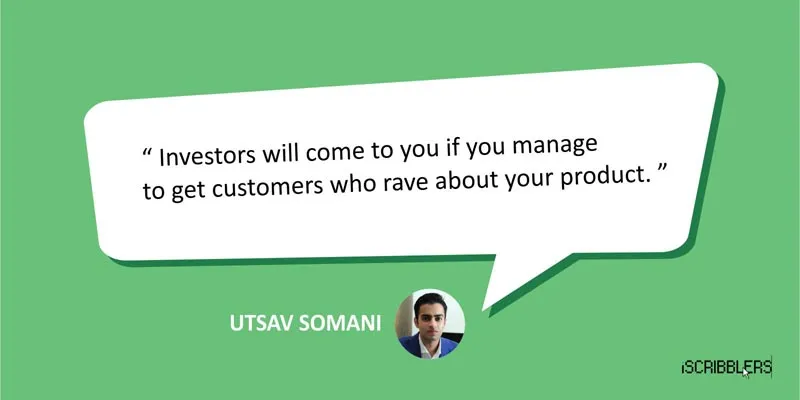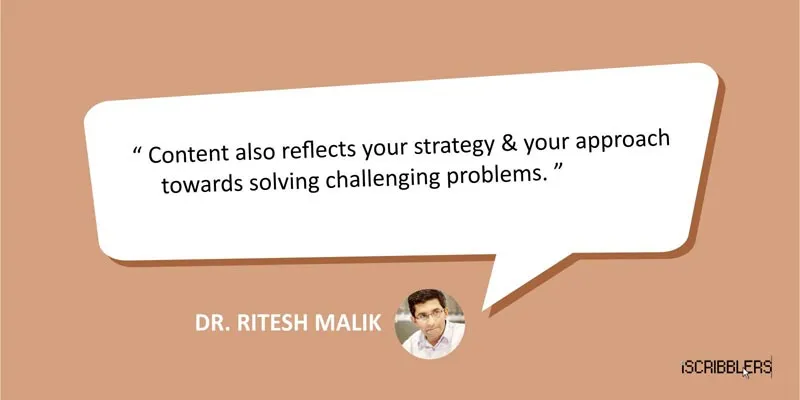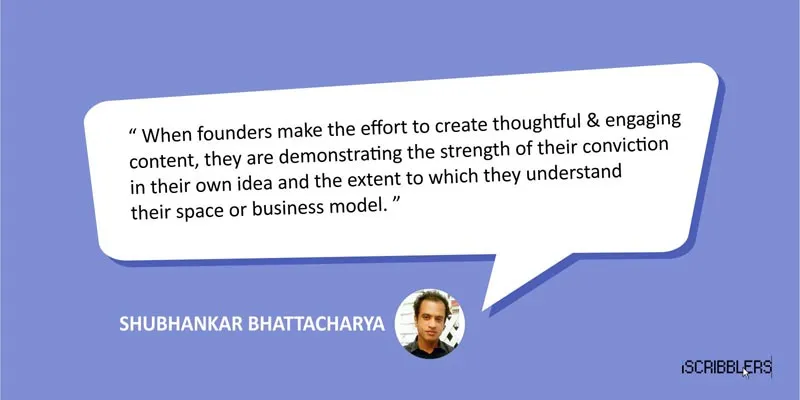3 Powerful ways to use content to engage with investors
Content when used rightly propels your startup towards more funding by giving a reason to reach out to investors.
Investors are keen to know the people developing a business and a reason to invest in them. Showcasing thought leadership through content plays an essential role in developing authority that investors look for.

After reading articles about crafting a pitch deck and how-to-guides for pitching to investors, it’s time to close the deal. But you’re still scratching your head on how to land that first meeting with the investor. You’re one among hundreds of small fishes in the huge pond with no real connections. Your goal is to gain exposure for your startup and to portray yourself as a thought leader.
Rand Fishkin, the founder and ex-CEO of Moz (a SaaS company selling inbound marketing and marketing analytics software) used content to show his thought leadership in SEO through guest posts, blog articles and webinars. This helped Moz raise more than $19 million in funding.
Why use content marketing to build investor relations?
Startups can leverage original content to gain controlled and planned exposure to investors. Content marketing can be used to gain the investor’s (much needed) attention, attract funding by showing your industry expertise and close those deals – all with staying at the top of their mind.
Here are the 3 powerful ways to use content to gain an investor’s attention and engage with them.
#1. A reason to reach out to them – Investors receive hundreds of emails each day pitching for funding. Most emails have a few lines about the startup and the CEO’s vision for how they’re going to make a difference to the world. Thoughtful emails where a founder is researching on a specific topic and needs valuable inputs and insights about the industry are rare.
While writing your next post, reach out to the investor you aim to meet with and approach her to provide an excerpt for your article. If you’re in on-demand industry and researching on it, reach out to an investor who has invested in other such on-demand startups and ask them to share their thoughts on the relevant topic.
The benefits you gain by reaching out to an investor include:
- Gaining a valued connection
- An expert validating your thoughts to strengthen the article
- Press coverage for the investor
- Respecting her opinion as an industry leader
Says Karthik Reddy, Managing Partner at Blume Ventures:
“Content marketing to get the attention of investors is still one of the most underused and under-appreciated amongst startup founders in India. Its a way to give all the investors one is connected to a heads up, many times a year, on a fixed schedule, without having to meet them in person. There are two parts to this - one is around the business knowledge itself and the other is around metrics / financial performance. I think most investors care more about the latter and that should be the highlight of a newsletter that's targeted solely to investors. The trick here is that the company has to be a) bold enough to put metrics that they aren't afraid will stop scaling and b) that it maybe leaked to competitors in a porous market. So, these are not financials but proxies for engagement metrics and other scaling parameters that can wow the investors.”

As per Utsav Somani, YourStory columnist and an Angel investor:
“Great use of #1 in reaching out to people like me. I think that writing about your product is a good way to attract customers more than investors. Investors will come to you if you manage to get customers who rave about your product. 'Thought leadership writing’ is not necessarily the only way to reach out to investors and not everyone’s cup of tea as well. Such writing’s purpose should be to drive ecosystem forward and open minds of those reading it to new ideas, thoughts and directions rather than being guided by a particular agenda. Evangelising your own product will only work to an extent.”

Practice the golden rule – give something before you ask for a favor and you’ll be amazed by the results.
#2. This shows your industry expertise – Investors invest in the founder/founding team rather than the idea. Give them a reason to believe in you, your industry expertise and thought leadership to gain a better chance in grabbing their attention for a meeting and subsequent investment deal.
Mention in your email the problem your startup solves and why it’s worth looking into. Include a link to a previous article you’ve written to show your deep understanding about the industry. Remember to discuss in short the crux of the article and the opportunities that lie ahead for your startup. Then ask for her inputs on the article you’re researching on.
An investor is interested in knowing how you’ll lead, nurture and grow your business and why you’re the best person in your industry to do so. What does it take to scale a company in your niche? How are you solving a problem? How are you different from the biggies in solving the same problem?
Adds Dr Ritesh Malik, an entrepreneur and investor:
“Usually investors, special at an early stage don’t take a lot of time to judge the team, they meet once or twice & write a cheque, most of my angel friends read a lot about the founder & google him/her to extract their thought process.
Content also reflects your strategy & your approach towards solving challenging problems. Just for an example, I am a doctor, have no idea about data sciences & data analytics, when an entrepreneur Veer Mishra from Neuron (data analytics platform) contacted me, I just went & googled him & found all the self-published content about what he did, on medium which helped me build a clear picture on what he does & helped increase my confidence in the team. Within a week I invested in Neuron & now it’s one of our shining portfolio stars.”

As per Shubhankar Bhattacharya, YourStory columnist and Venture Partner at Kae Capital:
"When it comes to early-stage investing, the quality of the founders is arguably the greatest determinant of potential success and one key characteristic we evaluate is the entrepreneur's ability to get customers/users, early hires and prospective investors to rally behind a vision. When founders make the effort to create thoughtful & engaging content, they are demonstrating the strength of their conviction in their own idea and the extent to which they understand their space or business model. Good content has the additional benefit of becoming search-engine friendly, facilitating discovery and positive word-of-mouth, which prove immensely useful when the startup has to impress upon early customers or employees. Given that such developments can have a significant impact on a startup's growth, we look very favorably at entrepreneurs taking the lead in creating original content."

Says Karthik Reddy, Managing Partner at Blume Ventures:
“The other category - industry insights or how your product is changing something fundamental at an industry - is the one to focus on for thought leadership. This set of content is far more incisive in the hands of potential customers, rather than just investors. Investors should receive these as well but I have noticed that these alone don't shift the faith of investors in the idea and the business potential.”

Share your startup’s unique stories, the challenges being solve, growth hacks and marketing strategies on your own blog and media platforms where your investors and target audience hang out.
#3. It expands your network – Each time that you publish an article, it expands your reach. Chances are, that the article is tweeted by someone and an investor whom you respect reads it. Alternately, if the investor whom you want to work with writes for the same media outlet, you can share your post with her and appreciate one of her writeup.
With every article you write, your network expands – through those whose excerpts you mention, who share it with their network and who read it online. Have a content team/marketer in place to consistently share your published posts with the target audience and key influencers in your industry.
In Karthik Reddy, Managing Partner at Blume Ventures’ opinion:
“I don't think its a good idea to spam folks. It yet takes a "good" face to face meeting before you can add an investor to a mailing list of either type - A or B above. Then, its fair to send it to them. Invariably, even though click-through and readership rates are likely to be 8-10% every time its sent, this could add up to a larger number if sent periodically through the year. And occasionally, the person will forward to it someone else who could be interested in investing or opening up a door to a portfolio company, even if to do diligence on what you're saying. All these are subtle network effects being created.”
Entrepreneurs, creating and publishing your own content is a powerful way to engage with investors by reaching out to them for their valuable inputs. Simultaneously it shows your thought leadership and expands your network. The same content can be used to share your message with the right audience and to land the sought after investor meetings.
(Disclaimer: The views and opinions expressed in this article are those of the author and do not necessarily reflect the views of YourStory.)







